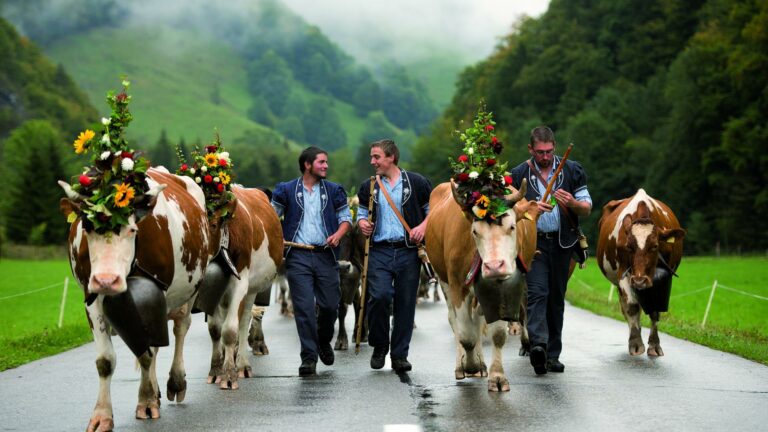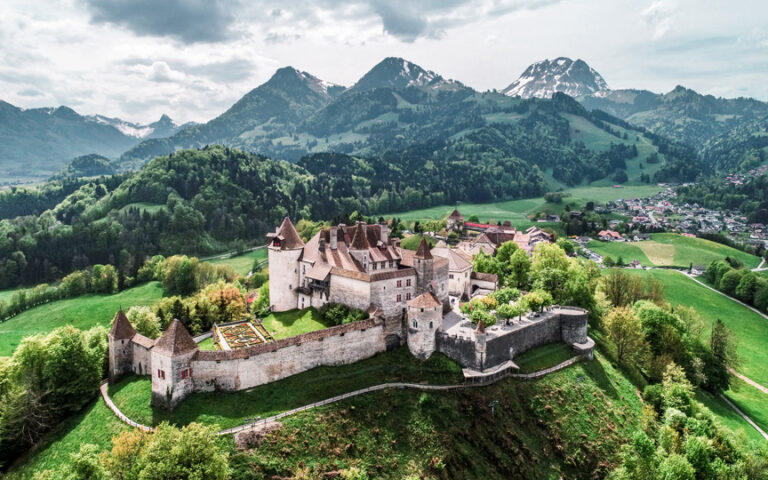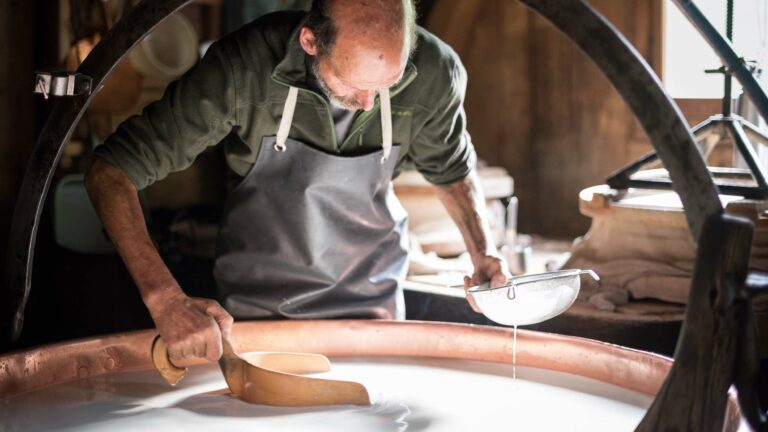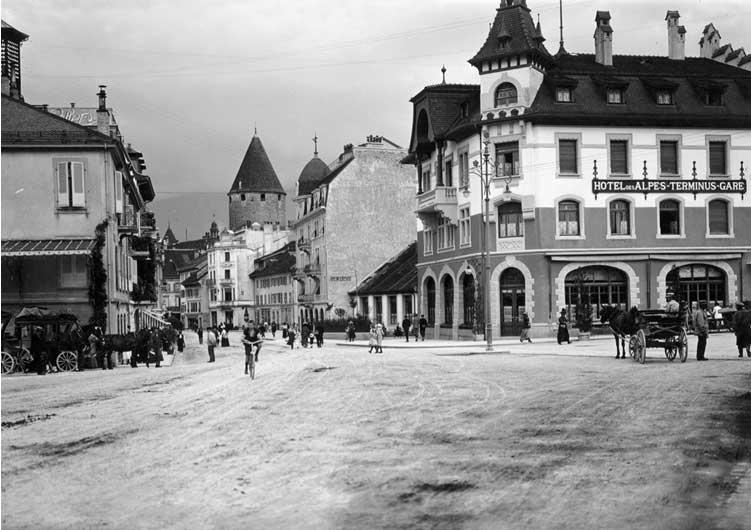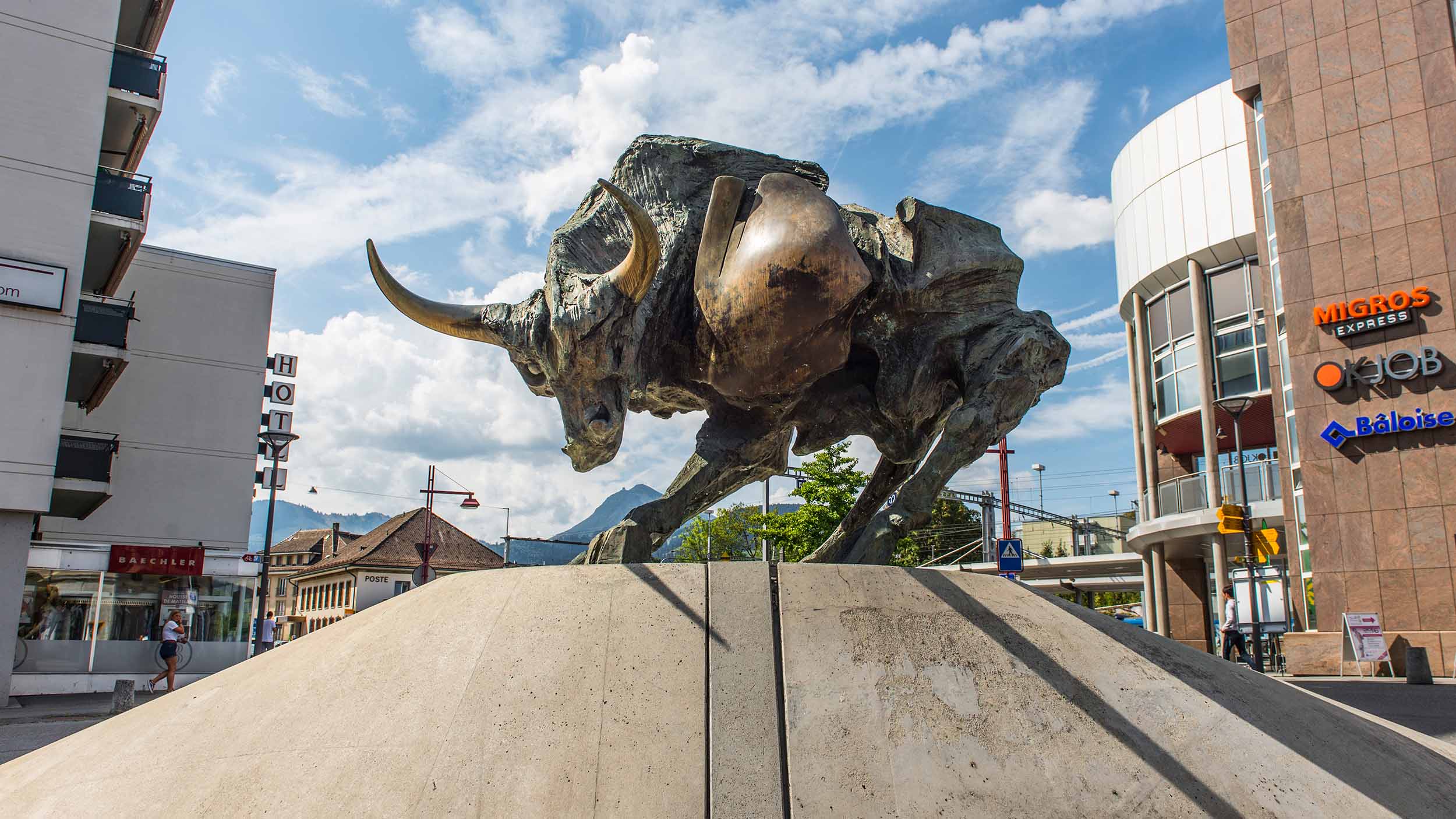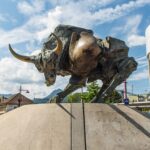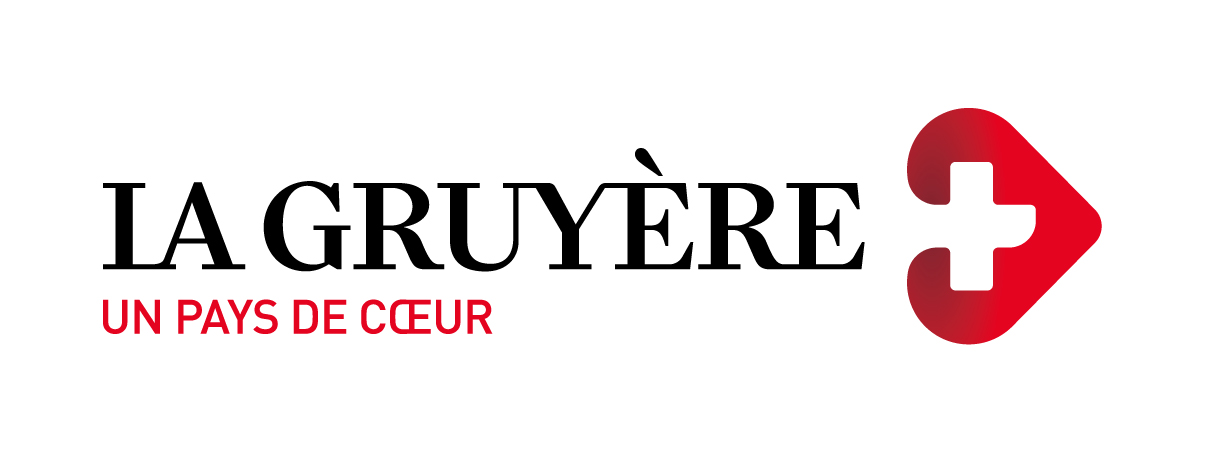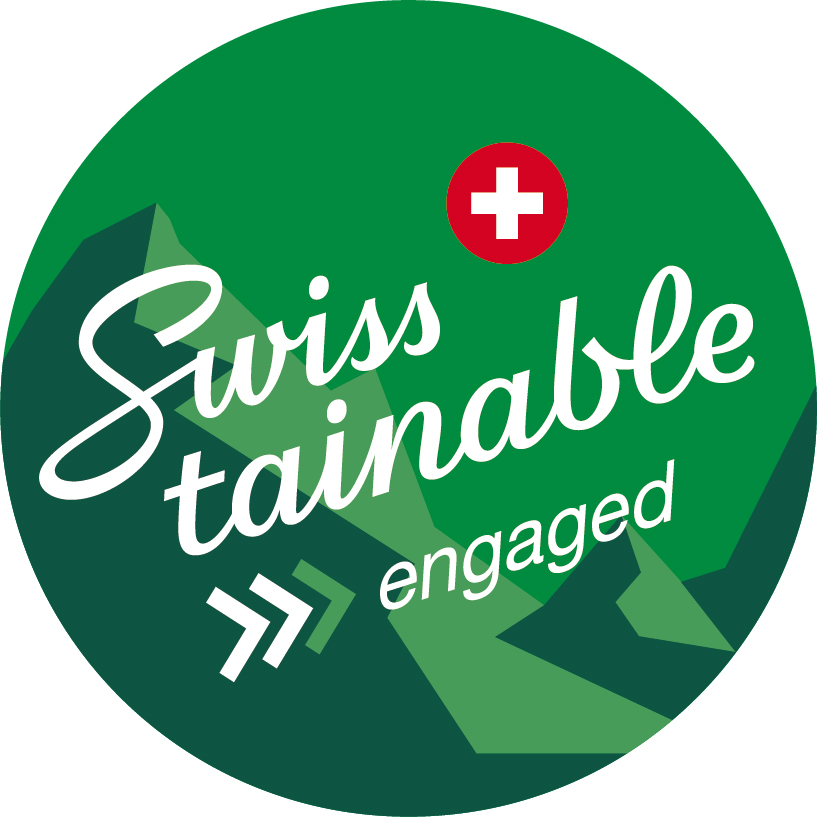The bull is the heraldic emblem of Bulle. This sculpture by the artist from Ticino Nag Arnoldi was offered to the town in 1996 in memory of Pierre Glasson (1907-1991), a former member of the government of the canton of Fribourg. The painting in the hall and the mosaics (1992) on the floor of the old railway station are the work of Jacques Cesa.
The bull sculpture, a work by the sculptor and native of Ticino Nag Arnoldi, was given to the town by Renée Glasson-Koller, in memory of her husband Pierre Glasson. It is installed in the centre of the roundabout on the Avenue de la Gare.
Nag Arnoldi
Nag Arnoldi, sculptor, painter and teacher. Born in Locarno (Ticino) in 1928, he was a frequent visitor to the workshops of different painters and architects in Lugano during the years of his artistic training. He later went to Murano where he studied techniques of glassmaking. In the 1950s he obtained a diploma in theatrical costume and set design. Painting, book art, ceramics and glassmaking became the tools of intensive research, which in the 1970s found its fullest expression in sculpture. His work is inspired in particular by the world of the circus and myth, with recurring figures such as warriors, horses and bulls. His technical mastery allows him to experiment with contrasts, for example the softness of flat surfaces and the rawness of materials, the mixing of hard, straight lines with free-floating curves. He has produced numerous works, including fountains in Lugano and Paradiso, as well as some imposing sculptures in Lausanne, Bulle, Giubiasco, Vaduz and Locarno. N. Arnoldi taught from 1962 to 1993 in the decorative arts section of the Centro Scolastico Industrie Artistiche in Lugano. He is a world-renowned artist and his work, inspired by his many travels in Europe and Latin America, can be seen all over the world. Several exhibitions have been devoted to him in the United States: in New York, San Francisco, Santa Fe and San Diego. N. Arnoldi has also exhibited at the National Museum of Modern Art of Mexico and in St-Petersburg, as well as in Switzerland, the United Kingdom, France, Germany and Italy.
© Musée gruérien
Pierre Glasson
Born 28.4.1907 in Bulle, died 4.5.1991 in Fribourg. Son of Edouard, a materials wholesaler, and of Marie Virginie Peyraud. Nephew of the photographer Simon Glasson and husband of Renée Koller. P. Glasson began his training in Bulle and Fribourg and later studied law in Fribourg, Berlin and Göttingen; he obtained his doctorate in 1937. Lawyer in Bulle (1938-1946). A deputy in Fribourg’s Grand Council (1941-1946), a communal councillor (executive) in Bulle (1942-1946), president of the Arts and Crafts Circle of Bulle and a member of La Gruyere’s radical party, P. Glasson cemented his popularity by successfully defending the protagonists of the Bulle riot in 1944. In 1946 he was elected to the Council of State, taking the seat from the conservative Joseph Piller, and until 1959 ran the Department of Justice, Communes and Parishes. Elected as a national councillor in 1946, he sat in parliament from 1951 to 1971 (due to an incompatibility of posts). He led the radical party at cantonal level (from 1946) and nationally (1964-1968). In 1959 he stepped down from government to focus on the private economy where he occupied a number of positions (tobacco and chocolate industries). A man of culture, P. Glasson was active in sponsorship and was president of the Landwehr Music Circle from 1963 to 1983. A Brigadier General, he commanded the Frontier 2 brigade.
© Dictionnaire historique de la Suisse
Several works of art were created by Jacques Cesa in the old train station. Below is the explanatory text written at the time by Jacques Cesa, an artist from Bulle and a member of the station’s artistic committee:
Bus station, train station; where the stars intersect at the junction of the Great Bear, I have dreamt since childhood of a beautiful, brightly painted station, resembling a canvas by Fernand Léger with its wealth of railway signals and signposts.
The pure beauty of the materials, station workers - railwaymen and technicians - merged by the artist with the colourful comings and goings of trains and locomotives...
A vast electronic network at the dawn of the 20th century, like a galaxy; the enduring rails and ballast, pristine and functional; journeys, travel, celebration. And in that boundless network connecting towns, cities and countries, travellers - children, men and women -momentarily pass through the station, carrying happy memories or dreams of holidays, or en route to work, morning and evening; employees, schoolchildren, mothers and their babies visiting the doctor, or pensioners arriving for a Thursday outing in Bulle and a game of cards. A vast network, a grand shop window for an entire region and for our guests, with that unavoidable detour for those on foot: the two stations, a land of stations; the bus station and the railway station.
The owner, architects and designers wished from the very outset to integrate art and artists in their huge undertaking. The presence of art is visible today in the choice of colours and materials.
In the old railway station, art finds expression in the main hall with its marble floor and granite towers that reach to a ceiling painted with a galaxy of stars at the junction of the Great Bear; the building’s granite facade shimmering in the sun through its veins of stone, copper-coloured in storms as the rain lashes down, with the station clock ever-present to tell the time.
© Musée gruérien
Also of interest
A bronze model of the bull at the Musée gruérien, in the section A Living Town of the permanent exhibition.
Find out more
Raoul Blanchard (et al.), Nag Arnoldi : château de Gruyères, exhibition catalogue, 2001
Dalmazio Ambrosioni, Nag Arnoldi 1980-2000: le esposizioni, le opere pubbliche, Ed. d'arte Ghelfi, Verona, 2001.
Nag Arnoldi : l'homme et le mythe, exhibition catalogue, Olympic Museum, Lausanne, 1999.
Giorgio Cortenova (et al.), Nag Arnoldi, Hoffmann, Frankfurt, 1992
Pierre Glasson (1907-1991), Bulle, 1994.
Archive photo:
Built during construction of Bulle-Romont railway station in 1868, the Avenue de la Gare underwent major transformations at the beginning of the 20th century: construction of the Hôtel des Alpes in 1906 and of the Bochud house in 1910 (today the La Potinière building). The Hôtel des Alpes was demolished in 1960. On the left in this photograph, taken around 1910, is the post and telegraph building.
© Charles Morel Musée gruérien
La Gruyère Tourisme
Centre commercial Velâdzo (rez inférieur)
Place de la Gare 3
1630 Bulle





